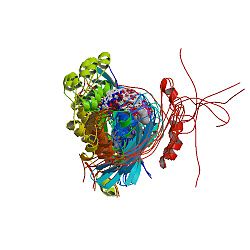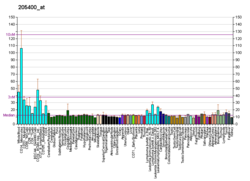Protein Wiskott–Aldrich syndrome
Protein Wiskott-Aldrich Syndrome (WASp) adalah protein yang terdiri dari 502 asam amino yang diekspresikan pada sel-sel sistem hematopoietik. Dalam keadaan tidak aktif, WASp berada dalam konformasi yang dihambat secara otomatis dengan urutan di dekat terminal-C yang mengikat ke daerah dekat terminal-N-nya. Aktivasi tergantung pada Cdc42 dan PIP2 yang bertindak untuk mengganggu interaksi ini, menyebabkan protein WASP untuk 'terbuka'. Domain yang terbuka di dekat terminal-C inilah yang mengikat dan mengaktifkan kompleks Arp2/3. Arp2/3 yang aktif selanjutnya akan memicu nukleasi F-aktin baru.
WASp adalah anggota pertama famili gen yang juga mencakup N-WASP (protein neuron Wiskott-Aldrich Syndrome), SCAR/WAVE1, WASH, WHAMM, dan JMY.[4][5] WAML (seperti WASP dan MIM) dan WAWH (WASP tanpa domain WH1) baru-baru ini ditemukan.[6]
Interaksi[sunting | sunting sumber]
Protein sindrom Wiskott-Aldrich telah terbukti berinteraksi dengan:
Referensi[sunting | sunting sumber]
- ^ a b c GRCm38: Ensembl release 89: ENSMUSG00000031165 - Ensembl, May 2017
- ^ "Human PubMed Reference:". National Center for Biotechnology Information, U.S. National Library of Medicine.
- ^ "Mouse PubMed Reference:". National Center for Biotechnology Information, U.S. National Library of Medicine.
- ^ "WASP and SCAR/WAVE proteins: the drivers of actin assembly". Journal of Cell Science. 122 (Pt 15): 2575–8. August 2009. doi:10.1242/jcs.023879. PMC 2954249
 . PMID 19625501.
. PMID 19625501.
- ^ "Under lock and key: spatiotemporal regulation of WASP family proteins coordinates separate dynamic cellular processes". Seminars in Cell & Developmental Biology. 24 (4): 258–66. April 2013. doi:10.1016/j.semcdb.2012.12.005. PMC 3656410
 . PMID 23291261.
. PMID 23291261.
- ^ "WASPs and WAVEs: from molecular function to physiology in hematopoietic cells". Seminars in Cell & Developmental Biology. WASP/WAVE proteins: expanding members and functions & The role of ploidy variation on cellular adaptation. 24 (4): 308–13. April 2013. doi:10.1016/j.semcdb.2013.03.002. PMID 23499790.
- ^ a b Tian L, Nelson DL, Stewart DM (March 2000). "Cdc42-interacting protein 4 mediates binding of the Wiskott-Aldrich syndrome protein to microtubules". The Journal of Biological Chemistry. 275 (11): 7854–61. doi:10.1074/jbc.275.11.7854. PMID 10713100.
- ^ Kim AS, Kakalis LT, Abdul-Manan N, Liu GA, Rosen MK (March 2000). "Autoinhibition and activation mechanisms of the Wiskott-Aldrich syndrome protein". Nature. 404 (6774): 151–8. doi:10.1038/35004513. PMID 10724160.
- ^ Kolluri R, Tolias KF, Carpenter CL, Rosen FS, Kirchhausen T (May 1996). "Direct interaction of the Wiskott-Aldrich syndrome protein with the GTPase Cdc42". Proceedings of the National Academy of Sciences of the United States of America. 93 (11): 5615–8. Bibcode:1996PNAS...93.5615K. doi:10.1073/pnas.93.11.5615. PMC 39296
 . PMID 8643625.
. PMID 8643625.
- ^ Symons M, Derry JM, Karlak B, Jiang S, Lemahieu V, Mccormick F, Francke U, Abo A (March 1996). "Wiskott-Aldrich syndrome protein, a novel effector for the GTPase CDC42Hs, is implicated in actin polymerization". Cell. 84 (5): 723–34. doi:10.1016/S0092-8674(00)81050-8. PMID 8625410.
- ^ Oda A, Ochs HD, Lasky LA, Spencer S, Ozaki K, Fujihara M, Handa M, Ikebuchi K, Ikeda H (May 2001). "CrkL is an adapter for Wiskott-Aldrich syndrome protein and Syk". Blood. 97 (9): 2633–9. doi:10.1182/blood.v97.9.2633. PMID 11313252.
- ^ a b She HY, Rockow S, Tang J, Nishimura R, Skolnik EY, Chen M, Margolis B, Li W (September 1997). "Wiskott-Aldrich syndrome protein is associated with the adapter protein Grb2 and the epidermal growth factor receptor in living cells". Molecular Biology of the Cell. 8 (9): 1709–21. doi:10.1091/mbc.8.9.1709. PMC 305731
 . PMID 9307968.
. PMID 9307968.
- ^ a b c d e f Banin S, Truong O, Katz DR, Waterfield MD, Brickell PM, Gout I (August 1996). "Wiskott-Aldrich syndrome protein (WASp) is a binding partner for c-Src family protein-tyrosine kinases". Current Biology. 6 (8): 981–8. doi:10.1016/s0960-9822(02)00642-5. PMID 8805332.
- ^ a b c Finan PM, Soames CJ, Wilson L, Nelson DL, Stewart DM, Truong O, Hsuan JJ, Kellie S (October 1996). "Identification of regions of the Wiskott-Aldrich syndrome protein responsible for association with selected Src homology 3 domains". The Journal of Biological Chemistry. 271 (42): 26291–5. doi:10.1074/jbc.271.42.26291. PMID 8824280.
- ^ a b c Rivero-Lezcano OM, Marcilla A, Sameshima JH, Robbins KC (October 1995). "Wiskott-Aldrich syndrome protein physically associates with Nck through Src homology 3 domains". Molecular and Cellular Biology. 15 (10): 5725–31. PMC 230823
 . PMID 7565724.
. PMID 7565724.
- ^ Banin S, Gout I, Brickell P (August 1999). "Interaction between Wiskott-Aldrich Syndrome protein (WASP) and the Fyn protein-tyrosine kinase". Molecular Biology Reports. 26 (3): 173–7. doi:10.1023/A:1006954206151. PMID 10532312.
- ^ Cory GO, MacCarthy-Morrogh L, Banin S, Gout I, Brickell PM, Levinsky RJ, Kinnon C, Lovering RC (November 1996). "Evidence that the Wiskott-Aldrich syndrome protein may be involved in lymphoid cell signaling pathways". Journal of Immunology. 157 (9): 3791–5. PMID 8892607.
- ^ Bunnell SC, Henry PA, Kolluri R, Kirchhausen T, Rickles RJ, Berg LJ (October 1996). "Identification of Itk/Tsk Src homology 3 domain ligands". The Journal of Biological Chemistry. 271 (41): 25646–56. doi:10.1074/jbc.271.41.25646. PMID 8810341.
- ^ McGavin MK, Badour K, Hardy LA, Kubiseski TJ, Zhang J, Siminovitch KA (December 2001). "The intersectin 2 adaptor links Wiskott Aldrich Syndrome protein (WASp)-mediated actin polymerization to T cell antigen receptor endocytosis". The Journal of Experimental Medicine. 194 (12): 1777–87. doi:10.1084/jem.194.12.1777. PMC 2193569
 . PMID 11748279.
. PMID 11748279.
- ^ Krause M, Sechi AS, Konradt M, Monner D, Gertler FB, Wehland J (April 2000). "Fyn-binding protein (Fyb)/SLP-76-associated protein (SLAP), Ena/vasodilator-stimulated phosphoprotein (VASP) proteins and the Arp2/3 complex link T cell receptor (TCR) signaling to the actin cytoskeleton". The Journal of Cell Biology. 149 (1): 181–94. doi:10.1083/jcb.149.1.181. PMC 2175102
 . PMID 10747096.
. PMID 10747096.
- ^ Okabe S, Fukuda S, Broxmeyer HE (July 2002). "Activation of Wiskott-Aldrich syndrome protein and its association with other proteins by stromal cell-derived factor-1alpha is associated with cell migration in a T-lymphocyte line". Experimental Hematology. 30 (7): 761–6. doi:10.1016/s0301-472x(02)00823-8. PMID 12135674.
- ^ Wu Y, Spencer SD, Lasky LA (March 1998). "Tyrosine phosphorylation regulates the SH3-mediated binding of the Wiskott-Aldrich syndrome protein to PSTPIP, a cytoskeletal-associated protein". The Journal of Biological Chemistry. 273 (10): 5765–70. doi:10.1074/jbc.273.10.5765. PMID 9488710.
- ^ Ramesh N, Antón IM, Hartwig JH, Geha RS (December 1997). "WIP, a protein associated with wiskott-aldrich syndrome protein, induces actin polymerization and redistribution in lymphoid cells". Proceedings of the National Academy of Sciences of the United States of America. 94 (26): 14671–6. Bibcode:1997PNAS...9414671R. doi:10.1073/pnas.94.26.14671. PMC 25088
 . PMID 9405671.
. PMID 9405671.
- ^ Antón IM, Lu W, Mayer BJ, Ramesh N, Geha RS (August 1998). "The Wiskott-Aldrich syndrome protein-interacting protein (WIP) binds to the adaptor protein Nck". The Journal of Biological Chemistry. 273 (33): 20992–5. doi:10.1074/jbc.273.33.20992. PMID 9694849.





